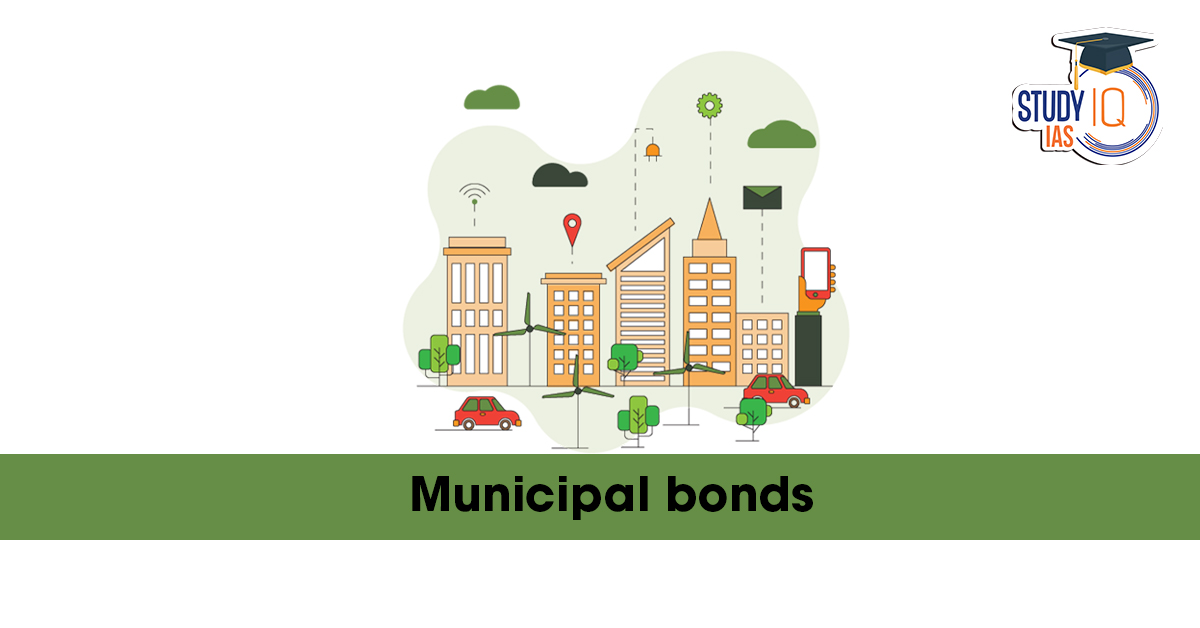Table of Contents
In a major boost to India’s urban finance ecosystem, the Finance Ministry (October 2025) announced that municipal bonds will now be eligible as collateral for repo and reverse repo transactions.
This landmark reform transforms municipal bonds into a liquid, tradable asset class, encouraging banks, mutual funds, insurance companies, and corporates to invest in them.
The move aims to deepen India’s municipal bond market, improve urban infrastructure financing, and reduce dependence on central or state government grants.
What Are Municipal Bonds?
Municipal bonds, also known as muni bonds, are debt instruments issued by Urban Local Bodies (ULBs) — such as municipalities or city corporations — to raise funds for public infrastructure projects.
When investors purchase these bonds, they are lending money to the municipal body, which agrees to repay the principal with interest after a fixed tenure.
Key Features of Municipal Bonds
-
Issuer: Urban Local Bodies (ULBs) like city corporations and municipal councils.
-
Purpose: Financing projects like water supply, sewage, housing, roads, and public transport.
-
Tenure: Usually 5–10 years.
-
Return: Fixed interest rate.
-
Regulator: Securities and Exchange Board of India (SEBI).
Legal and Regulatory Framework
The issuance and trading of municipal bonds in India are governed by:
-
SEBI (Issue and Listing of Debt Securities by Municipalities) Regulations, 2015
-
Companies Act, 2013 (where applicable)
-
Securities Contracts (Regulation) Act, 1956
-
Securities and Exchange Board of India Act, 1992
These regulations ensure transparency, disclosure, and accountability in how municipal bodies raise and use funds.
Types of Municipal Bonds in India
| Type | Description | Example |
|---|---|---|
| General Obligation Bonds (GOBs) | Backed by the issuer’s revenue sources like property tax or general funds. | Pune Municipal Corporation Bonds |
| Revenue Bonds | Linked to specific revenue-generating projects like toll roads or water treatment plants. | Hyderabad Water Supply Project Bond |
| Green Municipal Bonds | Issued for environment-friendly projects (renewable energy, waste management). | Indore Green Bond (2023) |
Evolution of Municipal Bonds in India
| Year | Milestone |
|---|---|
| 1998 | First municipal bond issued by Ahmedabad Municipal Corporation. |
| 2015 | SEBI introduced guidelines for listing and disclosure of muni bonds. |
| 2017–18 | GoI launched incentive scheme — ₹13 crore for every ₹100 crore bond raised. |
| 2023 | Indore and Pune issued green bonds for sustainable infrastructure. |
| 2025 | Government allowed municipal bonds as collateral in repo/reverse repo deals — creating a new asset class. |
Importance of Municipal Bonds
1. Financing Urban Infrastructure
With rapid urbanization, Indian cities require billions in funding for infrastructure. Municipal bonds help ULBs raise long-term capital for projects like:
-
Metro systems
-
Waste management
-
Smart City projects
-
Affordable housing
2. Reducing Dependence on Government Grants
They allow local bodies to generate funds independently, improving fiscal decentralization and financial autonomy.
3. Investor Benefits
-
Fixed returns and relatively low risk.
-
Tax benefits on certain bond categories.
-
New asset class diversification for institutional investors.
4. Boosting Credit Culture in ULBs
Bond issuance encourages transparency, auditing, and credit discipline, improving financial governance in municipal bodies.
Market Size and Growth
As per SEBI (September 2025):
-
Total funds raised: ₹3,300 crore through various issuances.
-
Over 10 new bond issuances expected in FY25–26 worth ₹1,500 crore (ICRA report).
-
Still small compared to Central/State Government securities, but growing steadily with policy support.
Recent Reform: Repo and Reverse Repo Eligibility (2025)
In October 2025, the Finance Ministry permitted the use of municipal debt securities as eligible collateral for repo and reverse repo transactions.
Significance of This Move
-
Enhances liquidity of municipal bonds.
-
Broadens investor base to include banks, insurers, and corporates.
-
Creates a new asset class in India’s financial market.
-
Encourages ULBs to issue more bonds for developmental projects.
This reform aligns with India’s goal of financial inclusion, capital market deepening, and urban self-reliance.
Challenges in India’s Municipal Bond Market
Despite its potential, the municipal bond market faces several structural challenges:
1. Weak Credit Profile of ULBs
Many municipalities lack strong revenue bases and depend heavily on grants, making investors cautious.
2. Poor Disclosure and Transparency
Inconsistent financial reporting and weak governance deter large investors.
3. Limited Awareness
Many local bodies lack the technical expertise to issue and manage bonds effectively.
4. Small Market Size
Despite new issuances, the municipal bond market is still a fraction of India’s ₹100+ lakh crore debt market.
Way Forward
To fully unlock the potential of municipal bonds, India needs:
-
Improved credit ratings and revenue collection systems for ULBs.
-
Mandatory financial disclosures and annual audits.
-
Greater state-level support in bond structuring and marketing.
-
Encouragement of ESG and Green Bonds to attract global sustainable investors.
Global Perspective
Countries like the USA, Japan, and Brazil have highly developed municipal bond markets.
For example, the US municipal bond market exceeds $4 trillion, funding schools, hospitals, and infrastructure at the local level.
India’s efforts — especially after the 2025 repo eligibility reform — aim to replicate this success by integrating ULBs into mainstream finance.
Conclusion
Municipal bonds are poised to become the future of urban financing in India.
By making them eligible for repo and reverse repo transactions, the government has opened the doors for greater liquidity, wider investor participation, and stronger city governance.
This marks a crucial step toward Atmanirbhar Urban India, where municipalities can raise funds independently for sustainable and inclusive growth.
With proper regulatory oversight, improved credit quality, and transparency, municipal bonds could soon evolve into a cornerstone of India’s financial and urban transformation.


 SHANTI Bill 2025: India Opens Nuclear Se...
SHANTI Bill 2025: India Opens Nuclear Se...
 Revamp of MGNREGA Scheme 2025
Revamp of MGNREGA Scheme 2025
 National Energy Conservation Awards 2025
National Energy Conservation Awards 2025

























